________________
66
reliefs showing the general design of the frontage. The elaborate description of the underground palace, a sort of Welbeck Abbey of ancient days, constructed by Mahosadha in his famous tunnel, is full of points of interest in this connection.' And the detailed account of the residences of members of the Order given in Vinaya Texts (3. 96, 104-115, 160-180) goes farther into minute details of the construction and ornamentation of the various portions of a human habitation. Then we have descriptions and basreliefs of the palace of the gods. And as gods are made in imitation of men, these are fair evidence also of the buildings in use by men at the time when the books were written, or the sculptures made. We have no space to enter fully into detail here. But the annexed illustration shows the ideas of a sculptor on the Bharahat tope as to the façade of a mansion, and the next shows his notion of what the meetinghall of the gods, part of Vejayanta, the palace in heaven, was like.'
BUDDHIST INDIA
It is not easy to determine from these illustrations whether the pillars and railings depicted are intended to represent woodwork, or stone carved in imitation of wood. I am inclined to think the latter is meant. If so, that would show that in the third century B.C. (the date of the bas-reliefs), stone was already much used. We have an extant example of stone walls surrounding a hill fortress before the sixth century B.C. (at Giribbaja, see above, p. 37). But in the
Jāt. 6. 430; translated in Yatawara's Ummagga Jātaka.
2 These gods must have been made by the clansmen in the free republics, or they would not have had a mote-hall.
Shree Sudharmaswami Gyanbhandar-Umara, Surat
www.umaragyanbhandar.com




